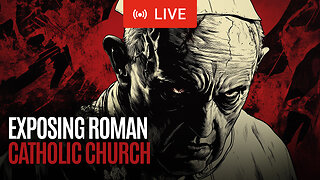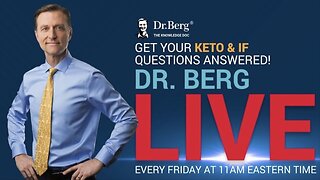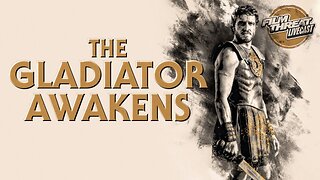Premium Only Content

Roman Catholic Church & Orthodox Church is False | #catholic #orthodox #church
https://linktr.ee/thechristianking
Join Stage: https://streamyard.com/79mp289t5m
The Roman Catholic Church and the Eastern Orthodox Church share many beliefs and practices that are seen as contrary to the Bible by evangelical and Protestant Christians. One of the primary teachings is Apostolic Succession, the belief that the authority of the apostles has been passed down through an unbroken line of bishops. Both churches uphold this doctrine, considering their clergy as direct successors to the apostles, thus claiming to hold the same spiritual authority.
Another significant area of contention is the veneration of Mary, which is highly developed in both traditions, though more so in Roman Catholicism. The Catholic Church teaches doctrines like the Immaculate Conception, the belief that Mary was conceived without original sin, her perpetual virginity, and the Assumption, which states that Mary was taken bodily into heaven. The Orthodox Church also holds Mary in high regard, venerating her as the "Theotokos," or "God-bearer," and often appealing to her intercessory role in prayer.
Closely related is the practice of praying to saints and Mary. Both churches teach that believers can pray to saints and Mary, asking them to intercede on their behalf. This practice stems from the belief that these holy figures, now in heaven, can act as intermediaries between God and humans. This is seen in many prayers, liturgies, and traditional practices where saints are invoked for protection, healing, and guidance.
The Roman Catholic and Eastern Orthodox Churches also emphasize the importance of the sacraments as means of grace. They believe that the sacraments—such as baptism, the Eucharist, confession, and others—are essential for receiving God's grace. For example, they view the Eucharist as a sacrament where believers partake in the real presence of Christ. In the Catholic tradition, this is known as transubstantiation, the belief that the bread and wine become the actual body and blood of Christ during the Mass. The Orthodox Church similarly holds to a mystical transformation in the Eucharist, though it does not strictly define this change as transubstantiation.
The concept of purgatory is another distinctive teaching of the Roman Catholic Church. Purgatory is believed to be a temporary state of purification for souls who have died in a state of grace but still require cleansing from venial sins before entering heaven. The Orthodox Church does not have a formal doctrine of purgatory but holds to similar ideas regarding the soul's purification after death through prayers for the departed.
Both the Catholic and Orthodox Churches place a strong emphasis on tradition. They consider Sacred Tradition, alongside Scripture, as a vital source of divine revelation. This includes the teachings of the Church Fathers, ecumenical councils, and various liturgical practices passed down through the centuries. In many cases, these traditions are held with equal authority to the Bible, guiding the interpretation of Scripture and the development of church doctrines.
The Papacy is a key feature of the Roman Catholic Church, which claims that the Pope, as the Bishop of Rome, is the supreme spiritual leader of all Christians and the direct successor to the Apostle Peter. The Pope is also believed to be infallible when making official declarations on faith and morals ex cathedra (from the chair of Peter). The Eastern Orthodox Church rejects the Pope's universal authority, instead operating through a synodal system led by various patriarchs and bishops, but both hold strong hierarchical structures rooted in apostolic succession.
Another practice common in both traditions is infant baptism. The Roman Catholic and Orthodox Churches baptize infants as a way to cleanse them of original sin and incorporate them into the faith community. This sacrament is viewed as the beginning of a child's spiritual journey, marking them as part of the Church from a very young age, even before they can personally profess faith.
Finally, the veneration of icons is a distinct practice in the Eastern Orthodox Church. Icons, which are religious images depicting Christ, Mary, and the saints, are treated with great reverence. They are used in worship, prayer, and liturgical services as visual representations that help believers connect with the divine. The veneration of these icons is seen as a way to honor the figures they represent and to aid in spiritual contemplation and prayer.
These teachings and practices, deeply rooted in centuries of tradition, distinguish the Roman Catholic and Eastern Orthodox Churches from many other Christian denominations, particularly those that emphasize a return to what they perceive as a more biblically grounded faith.
catholic, catholic church, catholic faith, roman catholic, catholicism, pope, vatican, pope francis, orthodox
-
 7:49:13
7:49:13
TheChristianKingTV
4 days agoExposing the False Teachings of the Roman Catholic & Orthodox Church | Christian Bible Study
197 -
 LIVE
LIVE
The Dilley Show
1 hour agoAmerica's Mayor, AG Pam Bondi and Q&A Friday! w/Author Brenden Dilley 11/22/2024
3,782 watching -
 LIVE
LIVE
Grant Stinchfield
1 hour agoRepublicans are a Greater Threat To Trump's Presidency than the Democrats
743 watching -
 1:00:50
1:00:50
The Dan Bongino Show
5 hours agoA Massive Shake Up On The Trump Transition (Ep. 2376) - 11/22/2024
702K1.36K -
 32:04
32:04
Stephen Gardner
17 hours ago🔥This Has GONE TOO FAR! Putin Begs Trump to intervene to avoid WW3!!
22.3K48 -
 1:01:56
1:01:56
Dr. Eric Berg
3 days agoThe Dr. Berg Show LIVE November 22, 2024
17.5K1 -
 55:10
55:10
The Rubin Report
2 hours agoPiers Morgan May Never Have This Guest on Again After This Fight
49.1K40 -
 56:35
56:35
Steven Crowder
3 hours agoLong-Distance Love, Choosing Your Church & Finding Out Your Dad is Gay | Tough Love w/ Guru Crowder
96.8K192 -
 LIVE
LIVE
Film Threat
4 hours agoGLADIATOR II + WICKED + TONS OF REVIEWS!!!!! | Film Threat Livecast
144 watching -
 59:11
59:11
The Big Mig™
12 hours agoGlobal Finance Forum Powered By Genesis Gold Group
3.91K2